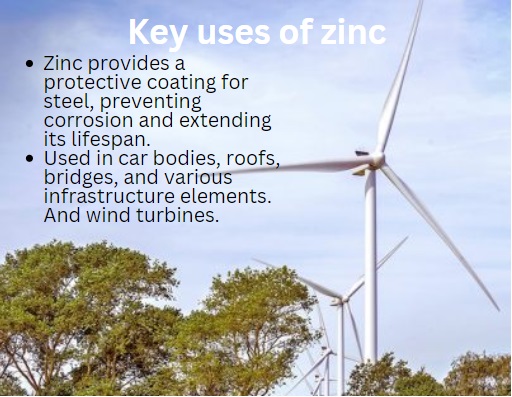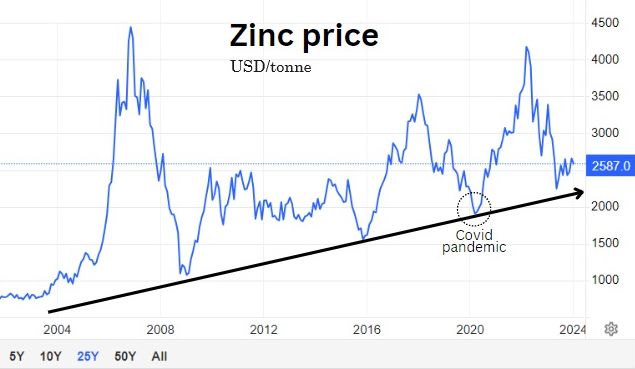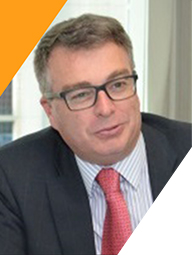| The energy transition, the shift from fossil fuels to renewable energy sources, is arguably one of the most significant endeavors of humanity. Various metals are crucial to the transition. Lithium is the most significant. Zinc is not at the frontline, which is why investors have not paid as much attention to zinc plays as they have with lithium miners. But notably there's one ASX-listed zinc play which is at an inflexion point in its progress (more on it later).  Historically, demand for zinc (and several other base metals) tracks global economic growth -- especially China's -- as it has been used in numerous applications, primarily to galvanise steel. In the energy transition, zinc's role includes:
|
 "For the outlook, I think you will start seeing the average zinc price more in the 3000s rather than the 2000s once we get through the little rough period in the current economy," says Martin Janes of Terramin Australia.
"For the outlook, I think you will start seeing the average zinc price more in the 3000s rather than the 2000s once we get through the little rough period in the current economy," says Martin Janes of Terramin Australia.
Chart: www.tradingeconomics.com
Along with lithium and several other metals, the price of zinc has had a roller-coaster ride in the recent past, touching a record high of US$4,800 per tonne in March 2022 but recently trading at only US$2,500.
 Martin Janes has been with Terramin for some 20 years. Formerly its CEO and CFO, he now works under a consultancy agreement to advance the company's major projects. Martin Janes has been with Terramin for some 20 years. Formerly its CEO and CFO, he now works under a consultancy agreement to advance the company's major projects. |
Terramin executive officer Martin Janes in an interview with NextInsight says this looks to be a bottom of the cycle as:
| • some zinc mines are shutting down because of operating losses, • some zinc mines in China -- a major global producer -- are constrained by stricter environmental laws and increasing operating costs, and • grades of ore of new zinc mines are declining, pushing up unit costs. |
Going forward, rising production costs with inflation are supportive of higher zinc prices.
When the cycle turns up on rising demand, whose timing depends on economic growth, it would likely favour Terramin Australia (current market cap: A$76 million) as its zinc mine in Algeria starts production in a few years' time.
| 5 things to know about Terramin |
1. Pivotal moment: Terramin holds a 49% stake in Western Mediterranean Zinc Spa (WMZ) -- which owns 100% of the Tala Hamza zinc project -- and holds management rights in respect of the project.
The remaining 51% of WMZ is held by two Algerian government-owned companies.
 "We have received the mining permit for the Tala Hamza Zinc Project. This is an enormous prize as Tala Hamza is a long-life low-cost world class project in a progressive jurisdiction on the doorstep of Europe." "We have received the mining permit for the Tala Hamza Zinc Project. This is an enormous prize as Tala Hamza is a long-life low-cost world class project in a progressive jurisdiction on the doorstep of Europe."-- Feng (Bruce) Sheng, Executive Chairman, Terramin Australia (AGM address, May 2023) |
The company, through some 20 years of exploration and studies in Algeria, has reached a pivotal moment. It has received approval to construct and mine at its Tala Hamza zinc project from the Algerian government.
The project has satisfied all Algerian regulatory, financial and environmental requirements and it can now proceed towards development and, in due course, mining and processing of 2.0 million tonnes per annum of ore over 20+ years.
2. Financing soon: For many months now, Terramin has been talking with various parties regarding the funding and construction of the project, and organising visits for them to the project site.
"We are talking to a number of construction companies for construction financing packages. We're also talking to a couple of banks that are aligned with these construction companies, and some Algerian development banks as well," says Mr Janes.
"There's a lot of liquidity in Algeria and they are looking for projects like this to finance."
3. Algerian backing: The government actively supports the project given its strategic importance for the country's development, including creating several thousand direct and indirect jobs for locals.
The government is scheduled to complete the acquisition of the land (234 hectares, equivalent of 390 football fields) in early 2024 and will lease it to the project.
Clearly, its purchase of the land reflects its confidence in the project.
"It takes out quite a significant capital cost for the joint venture company. It also speeds up the implementation of the project as the government uses its compulsory acquisition law to buy the land, paying a small premium to market value," says Mr Janes.
Further evidence of the government's role comes from the fact that being equity stakeholders of the project, the 2 Algerian government-owned companies (ENOF and ORGM) will contribute their share of capex and opex in due course.
4. Large rich deposit: Tala Hamza is one of the largest undeveloped zinc & lead deposits in the world.
Its resource amounts to 53Mt (Measured, Indicated and Inferred) at 5.3% zinc and 1.3% lead at a cut off grade of 2.5% zinc equivalent (inclusive of Probable Reserve).
Being high-grade and high volume, the zinc and lead ores require lower mining and processing costs compared to lower-grade ores.
In the big picture involving geopolitics, Tala Hamza will contribute to diversifying the global supply chain for zinc and lead, reducing global reliance on China which is a major producer of zinc.
5. Strong economics: Tala Hamza has low operating costs -- the mine is in Africa after all instead of high-cost Western nations -- and is located close to key facilities such as port, highways and airport.
|
"We're projecting that the all-in operating costs of Tala Hamza would reach US$0.60-$0.70 a pound. The zinc price today is still above US$1 a pound today." |
That factor coupled with a long life of mine will enable it to power through cycles, instead of shutting down during downturns.
"We're projecting that the all-in operating costs of Tala Hamza would reach US$0.60-$0.70 a pound. The zinc price today is still above US$1 a pound today," says Mr Janes.
Potentially, it will stay profitable in downcycles and be hugely profitable in upcycles.




